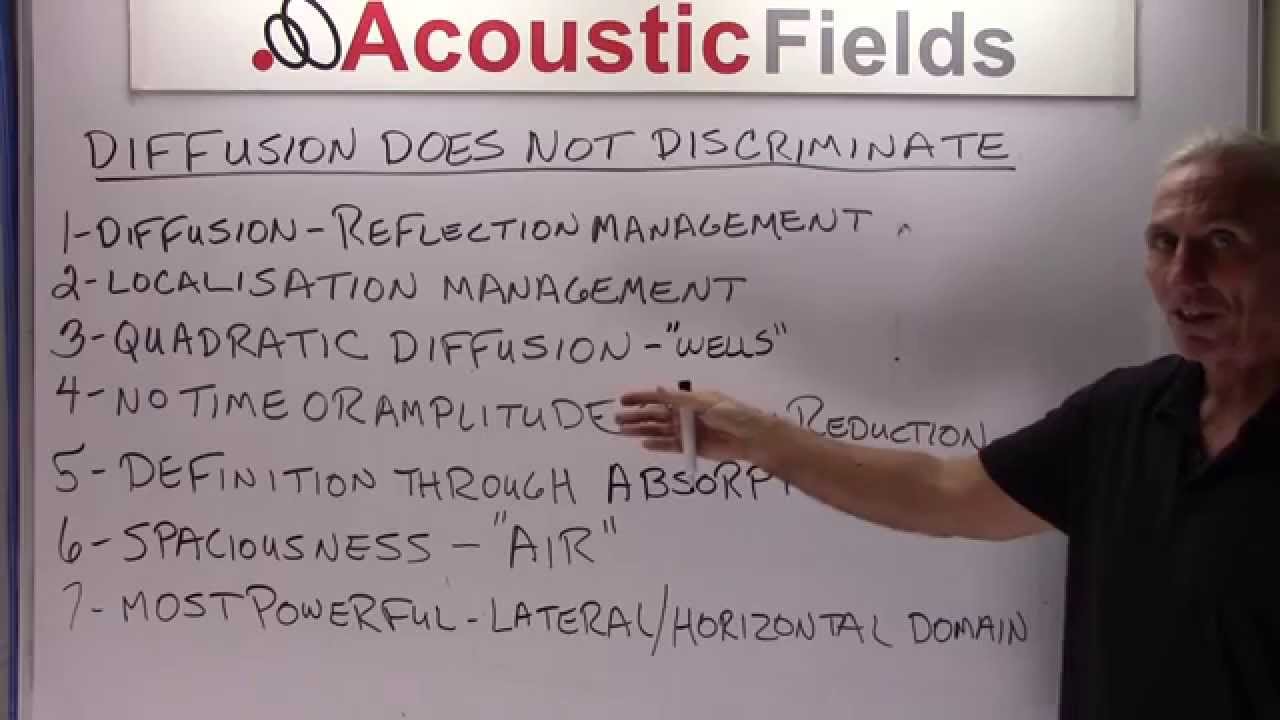Hi everyone, Dennis Foley from Acoustic Fields, today we’re going to talk about diffusion and why diffusion does not discriminate. What is diffusion? Well, everybody knows from our past videos that we use quadratic diffusion in our studios and in our room builds because it’s predictable and consistent. We like the fact that it has measured frequency response, we know that if we cover so much surface area, we get X result at that particular frequency response so we like the predictability and the consistency. Plus, it really looks good. If you build them out of wood, they really look great.
So it’s a device to manage reflections. And our room is full of reflections off our wall surfaces. Managing the time signature of those reflections through absorption is critical but diffusion also adds another element to it.
What is a quadratic diffuser? I think everybody knows what they are, they are series of wells or troughs that when energy enters the unit, based on the length of each well or trough which is quarter wavelength rule, the energy comes back.
Now the beautiful thing about quadratic diffusion is there is no reduction in time or amplitude of the signal. So when the energy, the reflection if you will enters the diffuser, it’s going to come back into your listing position with no reduction in time – it won’t be slower, it won’t be behind the original signal. And there is no strength differences or amplitude differences.
So it’s nice and smooth and it’s nice and even, properly placed, you don’t even know it’s there. And it helps eliminate also the localization effect that you get with a wall. Because we have this innate ability within our hearing system to recognize distances by the reflections bouncing back and forth between the surfaces of the room.
What the quadratic diffuser does is it kind of confuses the brain a little bit and it can’t localize. So it has the perception that the room is larger, the surface area is farther away from you. So that’s a good thing when it comes to listening in our rooms because the best sound will get us to not to have a room. Okay? Remember that.
Rooms are a big compromise and small rooms are a huge compromise. So you have to realize that quadratic diffusion has a lot going for it. How do you use it correctly?
Here’s how we do it. We get our definition through absorption. We look at the right rate levels of absorption for the particular issue we’re trying to address. But we always focus on definition. We want to get as much definition as we can without over-absorption. Once we achieve that definition through absorption, we then add our air or spaciousness through quadratic diffusion. So definition through absorption, spaciousness or air through diffusion. And quadratic diffusion is the most powerful in the lateral or the horizontal domain. So we know that a vertical diffuser positioned vertically spreads sound out in a horizontal direction. So that’s a very powerful domain for quadratic diffusion to work it. Could also use it on the ceiling, could also use it on front and rear walls but each has a different purpose and a function.
Hope this helps a little bit, you want to get your definition correct with absorption because once you put your absorption-defined signal into the diffuser, it’s going to give you exactly that kind of sound quality back. It will not discriminate. So you want to get your definition correct through absorption and then apply diffusion.
Thank you,
Dennis Foley
—
This is an unedited transcript from our video series from Acoustic Fields. There will be some errors in grammar and sentence structure that occur during this translation process.
For complete understanding and comprehension, please view the video which is included in this text. For any additional information regarding this topic or others relating to room acoustics, please contact us directly at:
P: 520 – 392 – 9486







